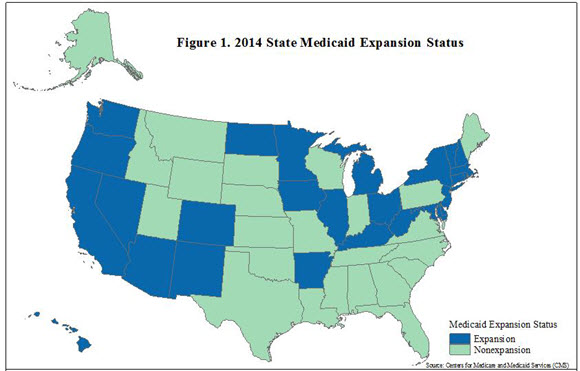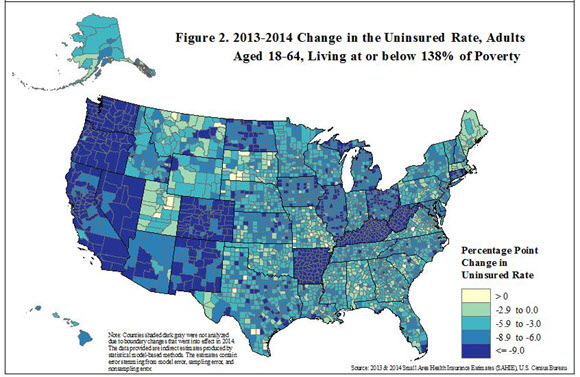
An official website of the United States government
Here’s how you know
Official websites use .gov
A .gov website belongs to an official government organization in the United States.
Secure .gov websites use HTTPS
A lock (
) or https:// means you’ve safely connected to the .gov website. Share sensitive information only on official, secure websites.
-
//
- Census.gov /
- Research Matters /
- Evaluating 2013-2014 Trends in County-Level Health Insurance Coverage for Low-Income Working-Age Adults
Evaluating 2013-2014 Trends in County-Level Health Insurance Coverage for Low-Income Working-Age Adults
Evaluating 2013-2014 Trends in County-Level Health Insurance Coverage for Low-Income Working-Age Adults
In 2014, many major provisions of the Patient Protection and Affordable Care Act went into effect. One key provision of the Affordable Care Act was the option for states to expand their Medicaid eligibility to most working-age adults living at or below 138 percent of poverty. During 2014, 26 states and Washington, D.C., chose to do so (See Figure 1).
Evaluating 2012-2014 Trends in Health Insurance Coverage for All U.S. Counties asks how health insurance coverage changed at the county level for low-income, working-age adults from 2013 to 2014. Did states that expanded their Medicaid eligibility criteria have more counties with decreasing uninsured rates?
Using Small Area Health Insurance Estimates (SAHIE) from the U.S. Census Bureau, we find that from 2013 to 2014, almost 60 percent of U.S. counties (1,877) had a decrease in their estimated uninsured rate for low-income, working-age adults (See Figure 2). In states that expanded their Medicaid eligibility, 96 percent of counties had a decrease in the SAHIE uninsured rate compared with 38 percent of counties in states that did not expand.
Large decreases in the estimated uninsured rate, nine percentage points or more, for low-income working-age adults, occurred in 51 percent of counties in expansion states compared with 4 percent of counties in nonexpansion states (See Figure 2, dark blue counties). Further, these declines in the uninsured rate for low-income, working-age adults were more pronounced among states that chose to expand their Medicaid eligibility than among states that chose not to expand eligibility.
The source data for our research are the published 2013 SAHIE and a preliminary version of 2014 SAHIE. The official 2014 SAHIE will not be published until late spring 2016. SAHIE publishes single-year health insurance coverage estimates for 3,141 U.S. counties annually by sex, with detail for five age groups and six income groups. The income groups include 0-138 percent of poverty, making SAHIE a vital source for evaluating county-level health insurance coverage for low-income individuals.
Although the 2013-2014 declines we observe in the uninsured rate among counties correlate with the implementation of state Medicaid expansions, we have not studied any policy causation, and so we cannot attribute changes in the uninsured rates to the implementation of the Affordable Care Act. However, since the SAHIE data uniquely capture uninsured rates at the county level for single years, they are an important resource for evaluating changes in health insurance coverage by detailed characteristics from 2013-2014 and in future years.
Share
 Yes
Yes
 No
NoComments or suggestions?


Top


